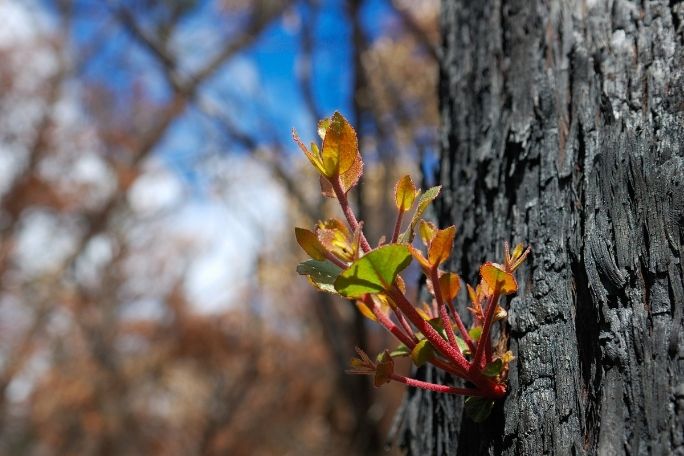Lesson summary
Students are introduced to the topic of bushfires and the Flora, Fauna, Fire resource from The Conversation. Students begin by thinking about the term ‘bushfire’ and completing a CSI activity to tune them into the topic. They then work collaboratively to develop discussion guidelines that can be used in this lesson and other lessons in this unit. Students then explore facts about bushfires, before spending time exploring the Flora, Fauna, Fire resource. Students can produce a poster or infographic to communicate their findings and reflections.
Learning intentions:
Students will...
- understand what a bushfire is
- recognise some of the causes and impacts of bushfires
- become familiar with the Flora, Fauna, Fire resource.
Success Criteria:
Students can...
- know and research facts about bushfires
- read, analyse and reflect on bushfire research
- work independently and collaboratively
- create discussion guidelines.
Lesson guides and printables
Lesson details
Curriculum mapping
Australian Curriculum content descriptions:
Year 7 Science:
- Science knowledge can develop through collaboration across the disciplines of science and the contributions of people from a range of cultures (ACSHE223)
- Summarise data, from students’ own investigations and secondary sources, and use scientific understanding to identify relationships and draw conclusions based on evidence (ACSIS130)
- Communicate ideas, findings and evidence based solutions to problems using scientific language, and representations, using digital technologies as appropriate (ACSIS133)
Year 9 Science:
- Scientific understanding, including models and theories, is contestable and is refined over time through a process of review by the scientific community (ACSHE157)
- Critically analyse the validity of information in primary and secondary sources and evaluate the approaches used to solve problems (ACSIS172)
- Communicate scientific ideas and information for a particular purpose, including constructing evidence-based arguments and using appropriate scientific language, conventions and representations (ACSIS174)
Syllabus outcomes: SC4-17CW, SC4-7WS, SC4-9WS, SC5-12ES, SC5-7WS, SC5-8WS, SC5-9WS
General capabilities: Literacy, Critical and Creative Thinking
Cross-curriculum priority: Sustainability OI.2.
Relevant parts of Year 7 Science achievement standards: Students describe situations where scientific knowledge from different science disciplines and diverse cultures has been used to solve a real-world problem. They summarise data from different sources and communicate their ideas, methods and findings using scientific language and appropriate representations.
Relevant parts of Year 9 Science achievement standards: Students describe social and technological factors that have influenced scientific developments and predict how future applications of science and technology may affect people’s lives. They use appropriate language and representations when communicating their findings and ideas to specific audiences.
This lesson is part of the wider unit of work Beyond the Bushfires – Secondary
Time required: 60 mins
Level of teacher scaffolding: Medium – facilitate class discussion
Resources required
- Bushfire questions
- Coloured pencils/markers
- Devices with internet access for students (to access the Flora, Fauna, Fire resource)
- Student Worksheets – one copy per student
Skills
This lesson is designed to build students’ competencies in the following skills:
- Communication
- Critical thinking
- Digital literacy
Additional info
In partnership with The Conversation, the Beyond the Bushfires series brings the words of scientists who are actively involved in research and science communication into classrooms throughout Australia. Students will explore evidence-based research embedded in the context of real-world practice.
Additional thanks to the Ian Potter Foundation, John T Reid Charitable Trusts and The Myer Foundation, for generously supporting the development of these lessons.


Welcome back!
Don't have an account yet?
Log in with:
By signing up to Cool.org you consent and agree to Cool's privacy policy to
store, manage and process your personal information. To read more, please see
our privacy policy here(Opens in new tab).
Create your free Cool.org account.
Many of our resources are free, with an option to upgrade to Cool+ for premium content.
Already have an account?
Sign up with:
By signing up to Cool.org you consent and agree to Cool's privacy policy to
store, manage and process your personal information. To read more, please see
our privacy policy here(Opens in new tab).